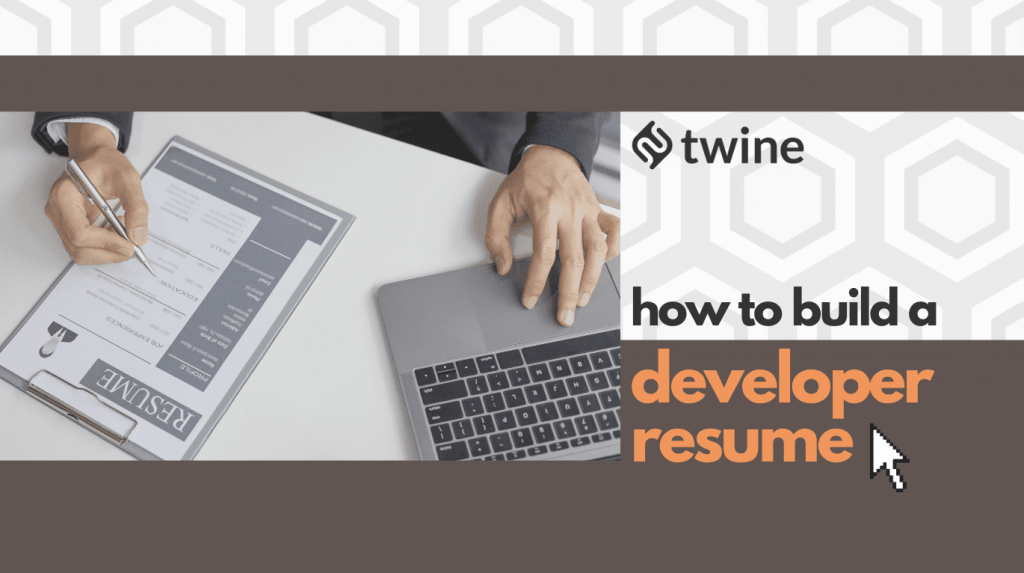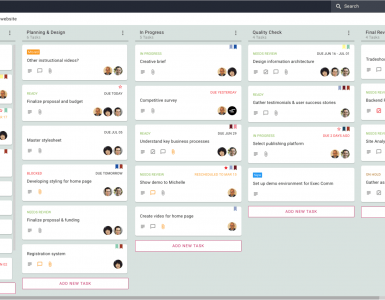
For more Productivity Tools, check out the Freelancer Toolkit…
As a developer, one of the most necessary (yet difficult) aspects of your freelancing career, is putting together a professional developer resume.
As a web developer, you’re probably quite skilled at creating impressive-looking web pages. Whether you use code to build new web pages, or, troubleshoot website issues.
Something that may not quite be your forte is writing a freelance resume. This might sound easy enough but remember, it has to showcase your skills and get you, new clients.
Ready to be recognized as an expert in your field? Join Twine today.
What is a Developer Resume?

A developer resume should focus on the projects you’ve completed, and how they specifically correlate to the new project you’re applying for. That means that while you should include a summary of your skills, you also need to explain how those skills were used. This will make your resume look more captivating.
Essentially, your developer resume is your chance to introduce yourself professionally. New companies and people looking to hire you for lucrative projects will review your developer resume first. It’s not a project to take lightly.
Give yourself a couple of hours where you can sit down and dedicate yourself (while fully rested) to typing up a resume that attracts customers.
Now the only question you’re probably wondering is: where do I start?
What Does Your Resume Need To Accomplish?

Before you start putting together your resume, first ask yourself: “what does my resume need to accomplish?”
In other words, what do clients want to see when they look at your resume? What will compel them to contact you for further discussions regarding the development project or job? Keep in mind most people aren’t going to spend more than a minute reviewing your resume, so, you have a short time frame to make a good impression.
That being said, building a developer resume shouldn’t be as intimidating as you may think. According to a recent study, the average resume for a freelance web developer is less than 400 words long. Just remember, you’re not writing a novel.
Here is a breakdown of a successful freelance developer resume:
- Outline your professional and relevant working experience
- List your fundamental hard skill strengths (i.e., your strengths in regard to specific web development tasks)
- Describe your fundamental soft skill strengths (i.e., your strengths that relate to how well you can work in a team, your work ethic, etc.)
- Display your organizational skills with a clear and easy-to-follow structure
- Be professionally written and free of spelling and grammar errors
- Include contact information (phone number, email, social media – mailing address is optional)
- Be modified for each potential client (this is perhaps the most overlooked aspect of resume writing because many freelancers craft just one resume that they send to all potential employers or job managers instead)
Any submitted resume that is successful with each of the above elements will stand out to potential employers more than a resume that doesn’t. So how can you start writing a resume that accomplishes each of the above?
Let’s dive right into it:
Writing Your Resume

Begin with your basic info
At the top of your resume, start with your basic information: your name, your freelance business name (if applicable), and your contact information. In regards to contact information, be sure to include your phone number, email address, and a link to your website and social media. Including a physical address is usually not necessary, but you can include your address if you so desire.
Additional basic information to consider including are:
- Your education (where you went to college or university, the year graduated, and your degree)
- Timezone
- Country of residence
- Native/fluent languages you speak and write
- Availability (part-time/full-time)
Add a summary
This is a two to three-sentence summary (usually located at the top of your resume) where you state who you are, what you can offer the client, and your expertise and experience. This is where you’ll be introducing yourself to the client before moving on to the information below.
Feature your relevant work + results
This is the bulk of your resume – list out some examples of your prior, relevant freelancing work.
This is a little bit different than simply listing “Job Title at [Company] – 2018-2020” as you would in a standard resume. Instead, you’ll be listing previous projects and the results that were generated. You need to mention how the project benefited the client – think something along the lines of “by optimizing [client’s] website for mobile devices, they experienced a 71% increase in mobile traffic…”.
Tailor-made
This is also where you may need to adjust your resume, depending on where you’re applying. In other words, be strategic about the past work you list out depending on who you’re applying to.
Developing a tailor-made resume for each new client may be more time-consuming, but, it can pay off. By listing out hyper-relevant work to the job prospect, you’re demonstrating the level of effort you’re willing to put into the role.
Additionally, if you have worked for any notable names in the industry you’re applying in, it’s usually worth mentioning for social proof. Find a balance of listing both relevant work and big-name clients.
The big mistake to avoid here is listing every development project you’ve ever worked on. Keep it shorter, be selective, and find the right balance between listing projects with big-name projects and projects relevant to the client.
Share your portfolio in a user-friendly way
Having a portfolio of your development work, ready to go, is also crucial when reaching out to new clients. Your portfolio showcases all of your prior work, including the work you don’t have listed in your resume.
The most user-friendly way to share your portfolio? Include a link to your website portfolio. Ideally, your portfolio will have media showcasing each project, and a link where they can find out more.
The last thing you want to do is to upload numerous files that have to be downloaded individually. All of your portfolio samples should already be uploaded to your site and easy to view there.
List your skills (hard skills and soft skills)
Listing your hard skills is where you’ll outline each aspect of web development that you’re experienced in.
Listing your soft skill strength is where you’ll list personality traits and key character attributes (such as your experience working in a team-based environment or your ability to communicate clearly and effectively).
Again, be specific and focus on specific skills (both hard skills and soft skills) that are most applicable to the job you’re applying for.
Include links to your social media accounts
Do you have any social media accounts that showcase your work? Be sure to include links to them as well. LinkedIn and Instagram business accounts are the most common accounts that freelance developers add to their resumes.
Why? Well, LinkedIn lists out your professional/work history, and Instagram is a great tool for showcasing prior examples of work.
Conclusion
Writing a successful and compelling resume is one of the most effective ways you can improve your freelance job prospects. Ultimately, it comes down to following a structured approach that showcases your development skills.
As a final piece of advice, have other people you trust take a good look at your resume and provide feedback. Chances are, they’ll catch something to improve that you missed.
Ready to get hired? At Twine, we have dozens of top-quality jobs being posted each and every day. From design to marketing, development to copywriting – there’s a job ready for your skills. Join the marketplace of diverse creative talent here.








